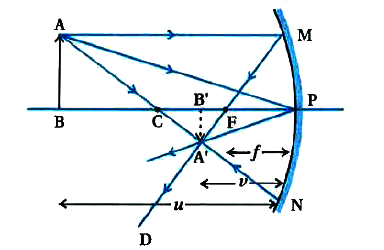Derive Dm=A(n21−1) for thin prism. Solution in Gujrati
Thin prism : "The prism which has small prisn angle is called thin prism". Refractive index of prism,
n=sin(A+δm2)sin(A2) …........ (1)
If A and δm is kept small then,
sin(A+δm2)sin(A2) =A+δm2 radian
sin(A2)=A2 radian
∴ Then equation (1) will be
n=A+δm2A2
n=A+sinmA
∴ nA=A+δm
∴δm=A(n−1)
δm depends on refractive index and prism angle of prism.
Topper's Solved these Questions
- RAY OPTICS AND OPTICAL INSTRUMENTSBOOK - KUMAR PRAKASHANCHAPTER - RAY OPTICS AND OPTICAL INSTRUMENTSEXERCISE - SECTION - A (TRY YOURSELF)
74 Videos
- RAY OPTICS AND OPTICAL INSTRUMENTSBOOK - KUMAR PRAKASHANCHAPTER - RAY OPTICS AND OPTICAL INSTRUMENTSEXERCISE - SECTION-B (NUMERICALS)(NUMERICAL FROM TEXTUAL ILLUSTRATIONS)
17 Videos
- MOVING CHARGES AND MAGNETISMBOOK - KUMAR PRAKASHANCHAPTER - MOVING CHARGES AND MAGNETISMEXERCISE - SECTION D (MCQs ASKED IN COMPETITIVE EXAMS)
34 Videos
- SAMPLE QUESTION PAPER BOOK - KUMAR PRAKASHANCHAPTER - SAMPLE QUESTION PAPER EXERCISE - PART-B SECTION-C
5 Videos
Similar Questions
Give range of wavelength of visible light.
View SolutionSuppose that the lower half of the concave mirror.s reflecting surface as shown in figure is covered with an opaque (non-reflective) material. What effect will this have on the image of an object placed in front of the mirror ?

View SolutionElectric charge Q having mass M moves on a circular path of radius R with velocity →v, perpendicular to uniform magnetic field B. When a particle completes one revolution, work done by the field is _______
View SolutionTwo charges –q and +q are located at points (0, 0, –a) and (0, 0, a), respectively.
(a) What is the electrostatic potential at the points (0, 0, z) and (x, y, 0) ?
(b) Obtain the dependence of potential on the distance r of a point from the origin when r/a>>1 .
(c) How much work is done in moving a small test charge from the point (5,0,0) to (–7,0,0) along the x-axis? Does the answer change if the path of the test charge between the same points is not along the x-axis?
View SolutionThin Prisms
View SolutionFor a glass prism of refracting, angle 60^@, the minimum angle of deviation, D_m is fonud to be 36^@ with a maximum error of 1.05^@, when a beam of parallel light is insident on the prism. Find the range of experimental value of refactive index mu. it is known that refractive index mu of material of prism is given by mu =(sin(A+D_m)/(2))/(sinA//2)
View Solutionसिद्ध कीजिए की कांच (.ang=32) के एक पतले प्रिज़्म को जब जल (.ann=43) में डुबो दिए जाता है तो प्रिज़्म द्वारा उत्पन्न विचलन कोण वायु के सापेक्ष 14 हो जाती है!
View Solutionएक काँच (ang=32) के पतले प्रिज्म द्वारा एक प्रकाश किरण का न्यूनतम विचलन कोण 40∘ है। यदि प्रिज्म को एक द्रव (an1=54) में डुबो दिया जाये तो न्यूनतम विचलन कोण कितना होगा?
View Solutionक्राउन काँच (nr=1.515,nv=1.525) का एक पतला प्रिज्म तथा फ्लिंट काँच (nr=1.612,nv=1.632) का एक पतला प्रिज्म इस प्रकार संयोजित है की उनके अपवर्तक कोण एक ही ओर है। दोनों के अपवर्तक कोण 5∘ है। इस संयोजक द्वारा उत्पन्न विक्षेपण का मान निकाले।
View SolutionA thin glass prism has a refracting angle of 6∘ . The angle of incidence is very small . What is the deviation produced by the prism , if the prism is kept in water ? [ang=1.5,anw=1.33]
View Solution4∘ प्रिज्म कोण वाले और 1⋅54 अपवर्तनांक के काँच का बना एक पतला प्रिज्म एक अन्य पतले प्रिज्म के साथ , जिसके काँच का अपवर्तनांक 1⋅72 हैं , विचलन रहित विक्षेपण उत्पन्न करने के लिए संयोजित किया जाता हैं | दूसरे प्रिज्म का कोण होगा -
View Solutionसिद्ध कीजिए -n12=1n21
View Solutiona prism of refractive index sqrt2 refracting angle A produces minimum deviation D_m of a ray on one face at an angle of incidence 45^@ . The values of A and D_m are respectively.
View SolutionExplain how the image is formed by thin convex lens and derive −1u+1v=(n21−1)[1R1+1R2]
View SolutionFor small prism angle, obtain D_m=(n_(21)-1)
View Solution
